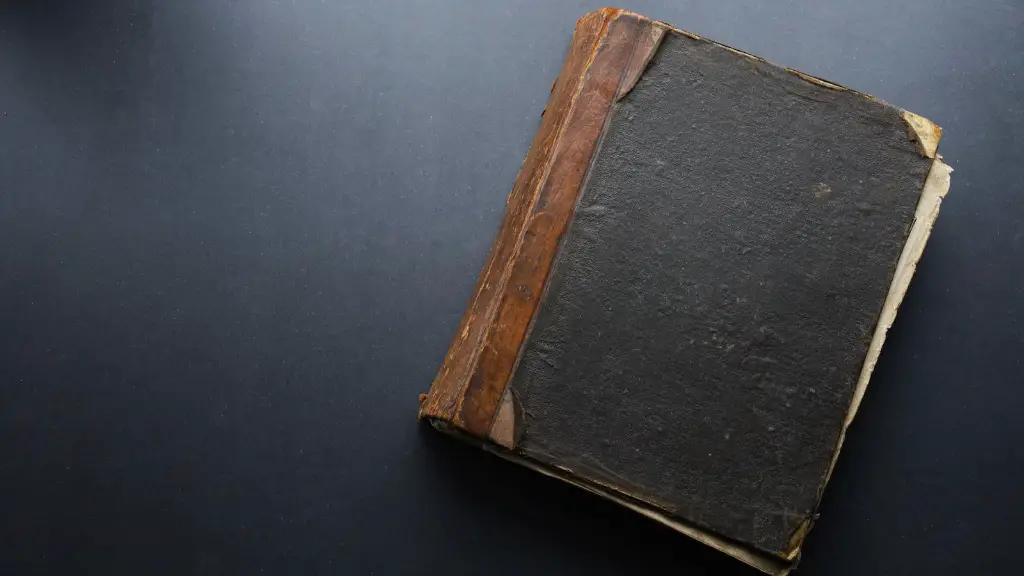Bethel is mentioned prominently throughout the Bible and is considered to be one of the most important places mentioned in the Bible. Bethel was first mentioned in the book of Genesis, where it is described as the place where Jacob saw his vision of angels ascending and descending a ladder. This event is recounted in the Bible in Genesis 28:10-22. According to the Bible, this is the place where Jacob set up an altar and made a vow to God. Bethel is also mentioned in the books of Exodus (Exodus 3:1-6), Numbers (Numbers 22:1-30), Joshua (Joshua 12:16-17), Judges (Judges 1:22-26), and 2Samuel (2Samuel 23:15-17). Bethel is also strongly associated with the prophet Elijah in the Bible, as this is the place where he is said to have received prophecy from God (1 Kings 19:9-18).
Bethel is believed to have been located in the ancient land of Canaan, at the edge of the hill country of the ancient region of Ephraim. It is believed to have been situated in the region of Shechem, which is located on the western side of the Jordan River. Bethel is believed to have been situated in a strategic location on the border between two of the most powerful nations of the ancient Near East. Ancient trade routes passed through this region, meaning that Bethel was located in a key trade hub that allowed for the exchange of goods, people, and ideas.
Archaeologists have unearthed evidence of ancient occupation at what is believed to be the site of Bethel. Excavations of the site have revealed artifacts from the Iron Age, which coincide with the hypothesized time of the Israelites’ entrance into the Promised Land. In particular, ancient pottery and images of the fertility goddess Asherah have been found, which are likely remnants of cultic activity at the site in ancient times. This is especially noteworthy given that Asherah was thought to be an important female deity in the ancient world. Thus, the presence of her artifacts at the site of Bethel serves as additional evidence of the presence of ancient cultures in the area.
The site of Bethel is still considered to be a holy land to this day. Jewish people who come to this spot can still offer prayers and say a special prayer for Bethel. In addition, the site is also considered to be a tourist destination, as people can explore its ancient ruins, which are amongst the oldest reclamations in the entire region. The site is also considered to be particularly important because of its strong association with the biblical narrative.
The importance of Bethel in the Bible has been the subject of much scholarly debate. Many scholars believe that the story of Jacob’s vision at Bethel serves to illustrate the profound and enduring power of faith. Other scholars suggest that Bethel is a symbol for the unification and cultural exchange between pagan and Hebrew traditions during the time of the Israelites’ entrance into the Promised Land. Still other scholars suggest that Bethel functions as a spiritual meeting place between God and man, where divine messages of hope and salvation are revealed. Regardless, it is clear that Bethel is an important place in the narrative of the Bible and that it continues to have a strong and profound relevance to this day.
Focus on the History of Bethel
The history of Bethel is closely intertwined with the biblical narrative. According to the Bible, it was at Bethel that Abram first heard God’s call and made the journey that would lead to the formation of the nation of Israel (Genesis 12:1-8). It was also at Bethel that Jacob encountered the mysterious ladder, which has been seen as an allegorical representation of a union between heaven and earth (Genesis 28:10-22). Furthermore, after the descent of the Ten Commandments, Moses instructed Joshua to build the first tabernacle at Bethel (Joshua 8:30-35) and Elijah is believed to have received his prophecy at this site (1 Kings 19:9-18).
Archaeologists have also noted evidence of ancient occupation at the site of Bethel. Excavations at the site have revealed artifacts from the Iron Age, which coincide with the hypothesized time of the Israelites’ entrance into the Promised Land. These artifacts include ancient pottery and images of the fertility goddess Asherah, suggesting that cultic activity was taking place at the site in the days of the early Israelites. In addition, ancient trade routes passed through this region, meaning that Bethel was located in a key trade hub that allowed for the exchange of goods, people, and ideas.
Bethel is still considered to be a holy spot to this day, particularly among Jews who travel to the site to offer prayers and petitions to God. It is also a tourist destination, with people flocking to explore its ancient ruins, as well as its strong connections with the biblical narrative. The importance of Bethel cannot be overstated, as it is one of the most prominent locations mentioned in the Bible and carries a message of hope and salvation that is echoed even to this day.
Focus on Archaeology of Bethel
Archaeologists have noted extensive evidence of ancient habitation at the site of Bethel. Excavations at the site have revealed artifacts from the Iron Age, which coincide with the hypothesized time of the Israelites’ entrance into the Promised Land. These artifacts include ancient pottery and images of the fertility goddess Asherah, suggesting that cultic activity was taking place at the site in the days of the early Israelites. In addition, ancient trade routes passed through this region, meaning that Bethel was located in a key trade hub that allowed for the exchange of goods, people, and ideas.
Archaeological evidence from Bethel indicates that it was an important Sinai cultic center in the Canaanite period, as well as a center for Iron Age Judah. As such, Bethel was likely the site of important ceremonies and rituals in ancient Israel. In addition, scholars have suggested that some of the cave systems could have been used for the storage of sacred objects, such as those associated with the cult of Yahweh. Additionally, the evidence suggests that the site of Bethel was also significant for early Christianity, as the ruins of a Byzantine monastery have been unearthed at the site.
This evidence of ancient occupation at the site of Bethel provides insight into the history and culture of ancient Israel. It is clear that Bethel was an important site in antiquity, both as a religious and trade center. Furthermore, the evidence suggests that it was a significant center of worship in the early days of the Israelites, as well as a spiritual meeting place between God and man.
Focus on Cultural Relevance of Bethel
The cultural relevance of Bethel is deeply intertwined with the biblical narrative. According to the Bible, this is the place where Abram first received the call to follow God’s plan, beginning the journey that would lead to the formation of the nation of Israel (Genesis 12:1-8). It is at Bethel that Jacob encountered the mysterious ladder, which has been seen as an allegorical representation of a union between heaven and earth (Genesis 28:10-22). Furthermore, after the giving of the Ten Commandments, Moses instructed Joshua to build the first tabernacle at Bethel (Joshua 8:30-35) and Elijah is believed to have received his prophecy at this site (1 Kings 19:9-18).
Bethel is still considered to be a holy site to this day. Jewish people who journey to this spot can still offer prayers and petitions to God, as well as celebrate the spiritual message conveyed through the biblical narrative. The site is also a tourist destination, with people flocking to explore its ancient ruins, as well as its strong connections with the biblical narrative. The importance of Bethel cannot be overstated, as it is one of the most prominent locations mentioned in the Bible and carries a message of hope and salvation that is echoed even to this day.
The cultural significance of Bethel has been a source of debate and discussion amongst scholars. Many scholars believe that the story of Jacob’s vision at Bethel serves to illustrate the profound and enduring power of faith. Other scholars suggest that Bethel is a symbol for the unification and cultural exchange between pagan and Hebrew traditions during the time of the Israelites’ entrance into the Promised Land. Still other scholars suggest that Bethel functions as a spiritual meeting place between God and man, where divine messages of hope and salvation are revealed. Regardless, it is clear that Bethel has a strong and enduring relevance for those seeking to uncover their spiritual self.
Focus on Historical Significance of Bethel
The historical significance of Bethel is closely linked to its role in the biblical narrative. According to the Bible, Bethel is the place where Abram first heard God’s call and made the journey that would lead to the formation of the nation of Israel (Genesis 12:1-8). It is also here that Jacob encountered the mysterious ladder, which has been seen as an allegorical representation of a union between heaven and earth (Genesis 28:10-22). Furthermore, after the descent of the Ten Commandments, Moses instructed Joshua to build the first tabernacle at Bethel (Joshua 8:30-35) and Elijah is believed to have received his prophecy at this site (1 Kings 19:9-18).
Bethel has also been the subject of much scientific research and archaeological discoveries. Excavations at the site have revealed artifacts from the Iron Age, which coincide with the hypothesized time of the Israelites’ entrance into the Promised Land. These artifacts include ancient pottery and images of the fertility goddess Asherah, suggesting that cultic activity was taking place at the site in the days of the early Israelites. In addition, ancient trade routes passed through this region, meaning that Bethel was located in a key trade hub that allowed for the exchange of goods, people, and ideas.
The historical significance of Bethel is the source of much debate and discussion amongst scholars. Many scholars believe that the story of Jacob’s vision at Bethel serves to illustrate the profound and enduring power of faith. Other scholars suggest that Bethel is a symbol for the unification and cultural exchange between pagan and Hebrew traditions during the time of the Israelites’ entrance into the Promised Land. Regardless, it is clear that Bethel is an important and significant place in the development of the nation of Israel and continues to have a profound relevance to this day.
Focus on Spiritual Significance of Bethel
The spiritual significance of Bethel is strongly associated with the biblical narrative. According to the Bible, this is the place where Abram first received the call to follow God’s plan, beginning the journey that would lead to the formation of the nation of Israel (Genesis 12:1-8). It is at Bethel that Jacob encountered the mysterious ladder, which has been seen as an allegorical representation of a union between heaven and earth (Genesis 28:10-22). Furthermore, after the giving of the Ten Commandments, Moses instructed Joshua to build the first tabernacle at Bethel (Joshua 8:30-35) and Elijah is believed to have received his prophecy at this site (1 Kings 19:9-18).
Bet




